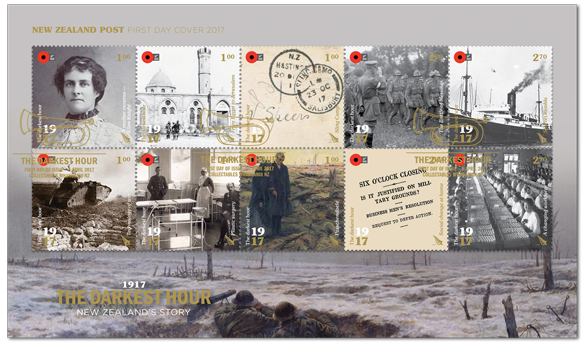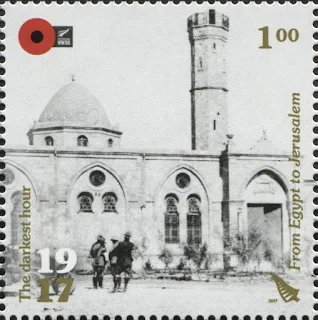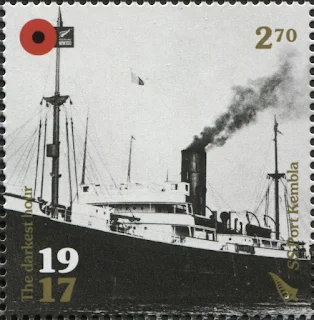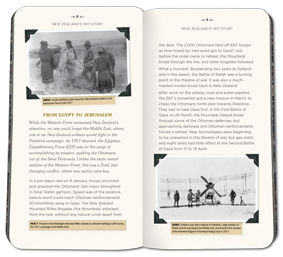By 1917, soldiers and loved ones had begun to lose faith in the ongoing war. Those on the Western Front were living in cold, wet trenches, and those at home were doing what they could to keep the home fires burning. New Zealand would experience the deadliest day in its military history when 845 lives were lost in the Belgian town of Passchendaele.
This sheet features the 6 x $1.00 stamps, the 2 x $2.20 stamps and the 2 x $2.70 stamps, all ten stamps of the Darkest Hour Issue.
All ten stamps on a First Day Cover.
The Stamps.
$1.00 - A mother mourns – Ellen Knight.
Ellen Knight from Dannevirke, who lost three of her sons during the First World War - A mother mourns.
$1.00 - From Egypt to Jerusalem.
From the Battle of Rafah, Egypt to the Battle of Jerusalem, via Beersheba, Palestine, went Anzac forces led by Major-General Chaytor and Brigadier-General Meldrum.
$1.00 - Sling Camp.
Letter from Sling Camp, Salisbury Plain to Hastings, New Zealand 23 Oct 1917 - 20 Dec 1917.
$1.00 - Technology of war.
Tank warfare at the Battle of Messines, 1917 - Technology of War.
$1.00 - Plastic surgery.
Dr Harold Gillies, pioneer of facial plastic surgery, in The Queen's Hospital, Kent, 1917.
$1.00 - Passchendaele.
Passchendaele, 12 October 1917, where 845 Anzac troops were killed, many of them buried at Tyne Cot Cemetery.
$2.20 - The Battle of Messines.
General Godley and soldiers of 2nd Infantry Brigade after the Battle of Messines Ridge, Belgium.
$2.20 - Social change at home.
"Six o'clock Closing, Is it Justified On Military Grounds? Business Men's Resolution Request To Defer Action." - Social change at home.
$2.70 - SS Port Kembla.
Australian Supply Ship SS Port Kembla, a merchant ship carrying war supplies, which was sunk by a German mine in New Zealand waters in September 1917.
$2.70 - A changing workforce.
To replace the 60,000 Kiwi men who had left New Zealand, many women entered the workplace: here, during a military service ballot, are women in the Census and Statistics Office Military Service Section in Routh's Building, Wellington.
The Miniature Sheets.
The set of two miniature sheets in the issue feature letters from members of the Knight family written during the war – Ellen and her sons would write back and forth constantly in a bid to stay connected. The miniature sheet with four stamps features a newspaper clipping reporting on the Battle of Messines, and the miniature sheet with six stamps features a newspaper clipping reporting on Passchendaele.
Above; - Miniature sheet of the four higher values.
Below: - The higher value sheeting on a First Day Cover.
Above; - Miniature sheet of the six lower values.
Below: - The lower value sheeting on a First Day Cover.
Commemorative Book.
The story of Ellen Knight and New Zealand’s role in the First World War throughout 1917 is told in greater detail in the commemorative book. The book is the fourth in a series of five and expands in depth on the story behind each stamp in this issue as well as supplying a more detailed glimpse of life during 1917.
Technical information.
Date of issue: 5 April 2017.
Number of stamps: Ten gummed stamps.
Denominations: 6 x $1.00, 2 x $2.20, 2 x $2.70.
Designed by: Strategy Design and Advertising, Wellington, New Zealand.
Printer and process: Southern Colour Print by offset lithography.
The number of colours: Four process colours.
Stamp size and format: 36.95mm x 37.5mm (horizontal).
Paper Type: Tullis Russell 104gsm red phosphor gummed stamp paper.
The number of stamps per sheet: 24.
Perforation gauge: 14.4 x 14.62.
Special blocks: Plate/imprint blocks could be obtained by purchasing at least six stamps from a sheet. Barcode blocks were available in A and B formats.
Period of sale: These stamps remained on sale until 4 April 2018. First-day covers remained on sale until 5 June 2017.
Some of the images in this post were used with permission from the illustrated catalogue of StampsNZ
You can visit their website and Online Catalogue at, http://stampsnz.com/
Information & images for this post came from.



















We appreciate your engagement with our content. To ensure a respectful and constructive community, please take note of the following:
- No Spam, Please: We do not tolerate spammy or promotional comments. Any such comments will be promptly removed.
- Moderation in Place: All comments are moderated to maintain a positive and inclusive environment. Please be patient, as it may take a little time for your comment to appear.
- Sign In with Google: To comment, please sign in using your Google account. This helps us maintain the integrity of our community and allows for better interaction.